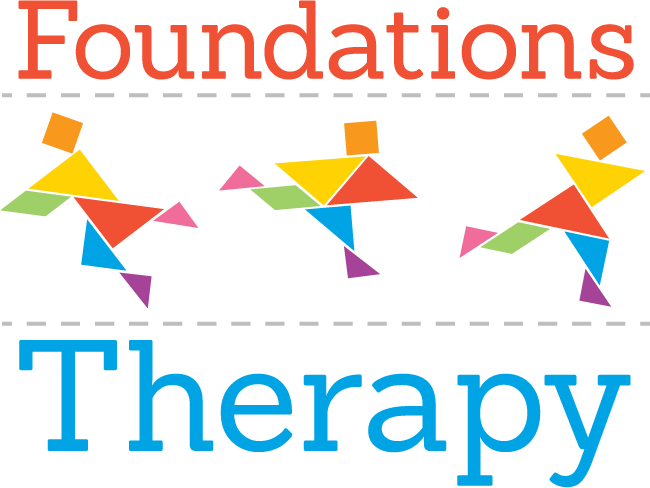Occupational Therapy

The Goals
- Independent in self-care
- Carry out everyday tasks
- Interact with others
- Play with a purpose
- Learn with confidence & improve skills
Discover the Power of Occupational Therapy
Building Independence
& Confidence in Children
The Journey Towards Independence
Pediatric occupational therapy is a specialized approach that fosters the development of the skills a child needs for daily activities such as dressing, eating, and school performance. Our therapists assess your child’s skills against age-appropriate developmental milestones. But, it doesn’t stop at practical skills.
OT also focuses on enhancing your child’s social and behavioral skills, boosting their confidence, and fostering a strong sense of accomplishment.
Unleashing the Power of Play
At Foundations Therapy, we understand that a child’s “occupation” is to play, learn, and grow. We harness this instinct, using play as a therapeutic tool. In our nurturing environment, therapists, children, and caregivers engage, interact, and play, transforming each session into a meaningful and motivating experience.
Our occupational therapists evaluate and treat the child using evidence-based practices, meaning that therapy sessions are client-centered and supported by quality research. The “magic” is using play as a therapeutic tool to improve a child’s occupations which promotes health, well-being, and overall quality of life.
How Can Pediatric Occupational Therapy Benefit Your Child?
OTs collaborate with parents, caregivers, teachers, and other healthcare professionals to provide a holistic approach to support the child’s development and improve their functional abilities in various environments. Pediatric OTs address a range of areas, including:
- Fine motor skills (handwriting, cutting, or using utensils)
- Gross motor skills (balance, coordination, and motor planning)
- Sensory processing
- Self-care skills (dressing, feeding/eating, bathing)
- Playing
- Social-emotional-behavioral skills (social interactions)
- School-related tasks (focusing, following directions, and transitions)
- Executive functioning skills (problem solving and flexibility)
- Functional visual skills
Pediatric Occupational Therapy
Tools We Use
To ensure your child receives the best possible support, we utilize a variety of innovative tools and programs, including:
Astronaut Training Program
This program is a protocol developed by Mary J. Kawar, MS, OTR, and Sheila M. Frick, OTR. This innovative program uses a sensory integrative protocol to stimulate and integrate the vestibular, visual, and auditory systems. The Astronaut Training Program is crucial for promoting sensory integration in children.
Alert Program
The Alert Program is a strategic tool that helps children understand their sensory needs and regulate their alertness levels. It’s particularly helpful for tasks requiring high mental engagement.
Balametrics, aka Belgau Learning Breakthrough Program
Known for enhancing balance and brain integration, Balametrics refines neural network firing processes. This program promotes increased efficiency in processing sensory information.
Brain Gym®
Movements, exercises, or activities that refer to the original 26 Brain Gym movements, sometimes abbreviated as the 26. Brain Gym® is a unique program that employs natural movements and exercises to improve children’s concentration, physical coordination, memory, and academic performance.
Getting It Write
The Getting It Write program focuses on the fundamentals of neat and legible handwriting. This six-week course provides techniques to overcome common handwriting difficulties.
Handling Techniques
Handling Techniques involve hands-on interaction with a child to teach body muscles how to move in specific patterns. These techniques help in improving alignment, muscle tone, and overall developmental skills.
Handwriting Without Tears® (HWT)
The Handwriting Without Tears® curriculum uses multi-sensory techniques and consistent habits to make handwriting an easy and comfortable task for children.
Infant Massage
Infant Massage combines techniques from various massage traditions. It provides tactile input which assists with regulation, circulation, gastro-intestinal issues, and improves bonding between child and adult.
Interactive Metronome®
The Interactive Metronome® is an assessment and training program that directly improves processing abilities affecting attention, motor planning, and sequencing.
Loops and Other Groups – A Kinesthetic Writing System
Loops and Other Groups uses movement patterns to teach cursive writing. It's a fun, imaginative approach that makes learning an engaging experience for children.
The MNRI Method
The MNRI Method uses specially trained techniques directed toward restoring the brain’s early neuronal circuits. This method is particularly beneficial for children who have experienced early developmental delays.
Therapeutic Listening®
An assessment and training program developed to directly improve the processing abilities that affect attention, motor planning, and sequencing. IM, in turn, strengthens motor skills, lengthens attention span, and improves processing functions, such as planning, organizing, and language.
Wilbarger Approach to Treatment of Sensory Defensiveness
The Wilbarger Approach is used for children who are over-responsive or under-responsive to sensory input. This approach significantly improves their ability to process and respond to sensory information effectively.
Handwriting Without Tears
Handwriting Without Tears is a hands-on writing approach that uses multi-sensory activities to learn how to write letters and numbers. It follows a developmental teaching order so that a child learns to write in a fun, successful way.
What People Say
The Magic of OT at Foundations
We believe in the power of play, learning, and growth, transforming each session into a meaningful experience for your child. Join us in our secure playground clinic and witness your child overcoming challenges, promoting their health, well-being, and enhancing their quality of life. Take the first step today!

